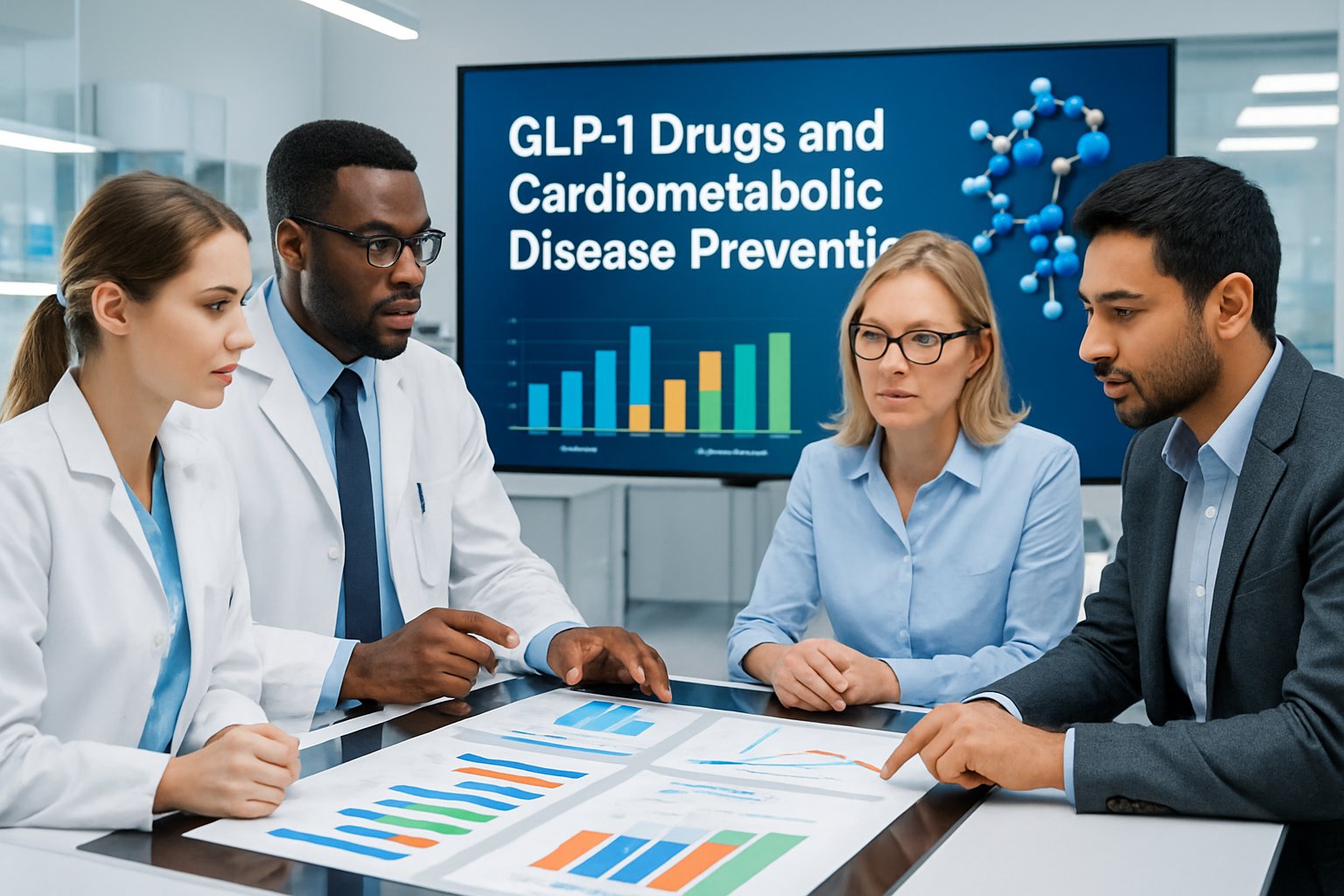GLP-1 drugs have moved far beyond their original role in type 2 diabetes care. These medications now play a central part in preventing and managing a wide range of cardiometabolic conditions, including heart disease, kidney disease, and obesity. They lower cardiovascular risk while also supporting weight management and metabolic health, making them one of the most important advances in modern medicine.
Clinical trials show that GLP-1 receptor agonists can reduce major cardiovascular events such as heart attack and stroke. Studies like the SELECT trial highlight their ability to improve long-term outcomes in people with obesity and type 2 diabetes. As research expands, new benefits continue to emerge, from slowing kidney disease progression to improving liver health.
This shift changes how doctors think about prevention. Instead of treating each condition separately, GLP-1 drugs target the shared pathways that connect obesity, diabetes, and cardiovascular disease. By addressing these links, they open the door to a more integrated and effective approach to long-term health.
Key Takeaways
- GLP-1 drugs improve both metabolic health and cardiovascular outcomes
- Evidence supports their use beyond diabetes treatment
- They represent a new model for preventing multiple chronic diseases
The Evolution of GLP-1 Drugs in Cardiometabolic Disease

Glucagon-like peptide-1 receptor agonists (GLP-1 RAs) have shifted from being glucose-lowering drugs to therapies with proven cardiovascular and metabolic benefits. Their history includes early discoveries in basic science, major clinical trials that tested outcomes beyond diabetes, and updated treatment guidelines that now recommend their use in broader patient groups.
Discovery and Development of GLP-1 Receptor Agonists
Researchers first identified glucagon-like peptide-1 (GLP-1) in the 1980s as a hormone that stimulates insulin release in a glucose-dependent manner. This discovery led to the development of GLP-1 receptor agonists, which mimic natural GLP-1 but resist rapid breakdown in the body.
The first approved GLP-1 drug was exenatide, derived from a peptide found in Gila monster venom. It demonstrated both glucose-lowering and weight reduction effects, paving the way for newer compounds.
Over time, longer-acting formulations such as liraglutide, dulaglutide, and semaglutide were introduced. These once-daily or once-weekly options improved adherence and expanded clinical use.
Today, GLP-1 RAs are recognized not only for type 2 diabetes management but also for benefits in obesity and cardiometabolic risk reduction. Their development reflects a steady progression from experimental peptide research to therapies that address multiple chronic conditions.
Key Milestones in Clinical Trials
Cardiovascular outcomes trials (CVOTs) played a central role in establishing the broader value of GLP-1 RAs. The LEADER trial, which studied liraglutide, showed reduced rates of major cardiovascular events in high-risk patients.
Other trials, including SUSTAIN-6 with semaglutide and REWIND with dulaglutide, confirmed similar benefits. More recently, the SELECT trial demonstrated that semaglutide reduced cardiovascular events in people with overweight or obesity even without diabetes, highlighting its impact beyond glucose control.
These trials consistently reported secondary benefits such as weight loss, blood pressure reduction, and renal protection. Collectively, they shifted GLP-1 RAs from diabetes drugs to agents with proven cardiometabolic protection.
The evidence base now supports their role as one of the few drug classes that improve both metabolic and cardiovascular outcomes, setting them apart from older therapies.
Changing Treatment Guidelines
The American Diabetes Association (ADA) and other professional groups have updated their recommendations in response to trial evidence. Current guidelines advise the use of GLP-1 receptor agonists in patients with type 2 diabetes and established cardiovascular disease, regardless of baseline A1C or metformin use.
These recommendations reflect a shift from glucose-centric treatment toward a focus on cardiovascular and metabolic risk reduction. Clinicians are encouraged to choose agents with proven cardiovascular benefit, such as liraglutide, semaglutide, or dulaglutide.
Guidelines also highlight the role of GLP-1 RAs in patients with obesity, supporting their use even when diabetes is not present. This aligns with findings from the SELECT trial and ongoing research into broader applications.
As evidence grows, treatment frameworks continue to evolve, positioning GLP-1 receptor agonists as a cornerstone in modern cardiometabolic care.
Mechanisms of Action: How GLP-1 Drugs Work

GLP-1 receptor agonists influence blood sugar control, body weight, and vascular health through multiple pathways. They act directly on pancreatic beta cells, slow digestion to reduce calorie intake, and affect vascular tissues to lower inflammation.
Glucose-Dependent Insulin Secretion
GLP-1 drugs bind to the GLP-1 receptor on pancreatic beta cells. This triggers insulin release, but only when blood glucose levels are elevated. This feature, called glucose-dependent insulin secretion, helps reduce the risk of hypoglycemia compared to drugs that stimulate insulin regardless of glucose levels.
They also suppress glucagon release from alpha cells. Lower glucagon reduces excess glucose production by the liver, which further improves blood sugar control.
Clinical studies show these drugs improve HbA1c levels more effectively than some older diabetes medications. By targeting both insulin and glucagon pathways, GLP-1 agonists provide dual regulation of glucose metabolism.
Effects on Gastric Emptying and Appetite
GLP-1 receptor agonists slow gastric emptying, meaning food leaves the stomach more gradually. This leads to a steadier rise in blood sugar after meals and reduces post-meal spikes.
They also act on appetite centers in the brain. Patients often report reduced hunger and fewer cravings. This effect supports weight loss, which is a key benefit for individuals with obesity or type 2 diabetes.
Approved medications such as semaglutide and liraglutide have shown significant weight reduction in clinical trials. As explained by Drugs.com, these drugs help patients feel full for longer periods, lowering overall calorie intake.
Together, delayed gastric emptying and appetite suppression make GLP-1 drugs effective for both blood sugar management and weight control.
Impact on Endothelial Cells and Inflammation
GLP-1 receptors are found on endothelial cells, the cells lining blood vessels. Activation of these receptors improves endothelial function by enhancing nitric oxide availability, which supports healthy blood flow.
Studies suggest GLP-1 drugs reduce systemic inflammation by lowering markers such as C-reactive protein. This anti-inflammatory effect may play a role in reducing cardiovascular risk.
According to a review in the National Library of Medicine, GLP-1 receptor agonists have been linked to fewer major cardiovascular events in patients with type 2 diabetes. This makes them valuable not only for glucose control but also for long-term vascular protection.
Cardiovascular Outcomes and Risk Reduction

GLP-1 receptor agonists have shifted the focus of diabetes care beyond glucose control by demonstrating measurable effects on cardiovascular outcomes. Large clinical trials now provide evidence that these drugs reduce major adverse cardiovascular events, including myocardial infarction, stroke, and cardiovascular death, particularly in patients with type 2 diabetes and high cardiovascular risk.
Evidence from Cardiovascular Outcome Trials
Cardiovascular outcome trials (CVOTs) were designed to test whether GLP-1 receptor agonists could safely lower blood glucose while also reducing cardiovascular risk. Studies such as LEADER, SUSTAIN-6, REWIND, and AMPLITUDE-O consistently showed benefits in high-risk patients.
In LEADER, liraglutide reduced cardiovascular death by 22%. SUSTAIN-6 found semaglutide lowered the risk of stroke by 39%. REWIND showed dulaglutide reduced major adverse cardiovascular events (MACE) even in patients without established cardiovascular disease.
The SURPASS-CVOT trial compared tirzepatide, a dual GIP/GLP-1 agonist, with dulaglutide. Results confirmed non-inferiority for cardiovascular protection, while also showing potential additional benefits in kidney outcomes and weight loss (Lilly’s report).
These findings confirm that GLP-1 receptor agonists provide cardiovascular protection across different patient groups, not only those with diabetes but also those with obesity and established heart disease.
Reduction of Major Adverse Cardiovascular Events
MACE includes cardiovascular death, nonfatal myocardial infarction, and nonfatal stroke. Across multiple CVOTs, GLP-1 receptor agonists consistently reduced the risk of this composite outcome.
A meta-analysis of eight trials found a 14% reduction in MACE, a 13% reduction in cardiovascular death, and a 16% reduction in stroke among patients treated with GLP-1 drugs (Cardiovascular and renal outcomes review).
The SELECT trial extended these findings to patients with obesity but without diabetes. In this study, semaglutide reduced MACE by 20% and myocardial infarction by 28%. This suggests that the cardiovascular benefits are not solely dependent on glucose lowering but may also involve weight loss and direct vascular effects.
These results highlight the role of GLP-1 receptor agonists as disease-modifying therapies that address both metabolic and cardiovascular risk.
Benefits in Atherosclerotic Cardiovascular Disease
Atherosclerotic cardiovascular disease (ASCVD) remains the leading cause of death in type 2 diabetes. GLP-1 receptor agonists have shown benefits in patients with established ASCVD by lowering the risk of recurrent events.
In patients with prior myocardial infarction or stroke, GLP-1 therapy reduced the likelihood of future events, with semaglutide and liraglutide showing the strongest evidence. Trials also suggest improvements in vascular function and reductions in inflammation, which may explain the observed outcomes (AHA review).
Evidence indicates that GLP-1 receptor agonists are most effective for patients with multiple cardiovascular risk factors or established ASCVD. This positions them as a key therapy not only for diabetes management but also for long-term cardiovascular risk reduction.
By targeting both glucose metabolism and vascular health, GLP-1 drugs are redefining how clinicians approach the prevention of recurrent cardiovascular events in high-risk populations.
Expanding Indications: Beyond Type 2 Diabetes

GLP-1 receptor agonists, once limited to blood sugar control, are now showing benefits across multiple chronic conditions. Evidence highlights their role in weight reduction, prevention of cardiometabolic disease, and protection of kidney and liver function.
Obesity and Weight Management
GLP-1 drugs support chronic weight management by reducing appetite and slowing gastric emptying. Clinical trials demonstrate that adults with overweight or obesity who do not have diabetes can achieve meaningful weight loss with medications like semaglutide and tirzepatide.
These effects extend beyond short-term outcomes. Studies show that sustained use leads to reductions in waist circumference, blood pressure, and lipid levels, key risk factors for cardiometabolic disease.
| Key Outcomes | Evidence |
|---|---|
| Average weight loss | 10–15% of body weight in many trials |
| Improvements | Blood pressure, cholesterol, waist size |
| Impact | Reduced risk of cardiovascular events |
GLP-1 therapies are now approved for obesity treatment in adults without diabetes, marking a shift toward broader use in public health. This expansion reflects their ability to address both medical and quality-of-life concerns linked to excess weight.
Primary Prevention in At-Risk Populations
Beyond treatment, GLP-1 drugs are being studied for primary prevention in people at risk of cardiometabolic disease. Adults with overweight, prediabetes, or cardiovascular risk factors may benefit from early intervention.
Evidence suggests these drugs lower the risk of heart attack, stroke, and cardiovascular death in both diabetic and non-diabetic populations. In the SELECT trial, semaglutide reduced major cardiovascular events in people with obesity but no diabetes, showing its potential as a preventive therapy (link).
Key preventive benefits include:
- Reduced progression from prediabetes to type 2 diabetes
- Lower rates of cardiovascular events
- Improved long-term weight stability
This positions GLP-1 drugs as tools not only for treating disease but also for delaying or avoiding its onset in high-risk groups.
Renal and Liver Benefits
Research shows GLP-1 receptor agonists provide renal protection, especially in patients with type 2 diabetes at risk for chronic kidney disease (CKD). Clinical trials report slower progression of kidney damage, reduced albuminuria, and lower incidence of end-stage renal disease (link).
Benefits extend to metabolic liver disease. In trials of patients with non-alcoholic steatohepatitis (NASH), GLP-1 therapy improved liver enzymes and reduced fat accumulation. Recent phase 3 data with semaglutide suggest potential for broader use in metabolic liver disorders.
| Condition | Reported Effect |
|---|---|
| CKD | Slower decline in kidney function |
| End-stage renal disease | Lower risk in long-term studies |
| NASH | Improved liver histology and reduced inflammation |
These findings highlight how GLP-1 therapies may reduce complications that often overlap with obesity and diabetes, reinforcing their role in managing complex metabolic disease.
Comparing GLP-1 Drugs: Efficacy and Safety Profiles

Different GLP-1 receptor agonists vary in dosing schedules, weight loss effects, and cardiovascular outcomes. Safety considerations, including gastrointestinal side effects and long-term tolerability, also differ across medications and trials.
Semaglutide, Liraglutide, and Tirzepatide
Semaglutide, marketed as Ozempic for diabetes and Wegovy for obesity, has shown strong reductions in both HbA1c and body weight. Weekly dosing improves adherence compared to daily regimens. Clinical data also suggest cardiovascular protection in patients with type 2 diabetes.
Liraglutide (Victoza, Saxenda) requires daily injections and produces less weight loss than semaglutide. However, it has well-documented cardiovascular benefits, especially in high-risk patients.
Tirzepatide (Mounjaro, Zepbound) is a dual GLP-1/GIP receptor agonist from Eli Lilly. It has demonstrated greater reductions in HbA1c and body weight than semaglutide in trials like SURPASS-2. Gastrointestinal side effects remain common, but discontinuation rates are similar to other agents.
| Drug | Brand | Dosing | Key Effects | Notable Points |
|---|---|---|---|---|
| Semaglutide | Ozempic, Wegovy | Weekly | Strong weight loss, HbA1c reduction | CV benefit |
| Liraglutide | Victoza, Saxenda | Daily | Moderate weight loss | Proven CV outcomes |
| Tirzepatide | Mounjaro, Zepbound | Weekly | Largest HbA1c and weight loss | Dual mechanism |
Dulaglutide and Other Agents
Dulaglutide (Trulicity, by Eli Lilly) is a once-weekly GLP-1 agonist with proven cardiovascular benefits. In the REWIND trial, it reduced major adverse cardiovascular events even in patients without established cardiovascular disease. Its tolerability is similar to semaglutide, with nausea and vomiting as the most frequent side effects.
Other agents, such as exenatide and lixisenatide, are less commonly used today due to weaker efficacy and more frequent dosing. Newer long-acting formulations have largely replaced them in clinical practice.
Comparisons across trials show dulaglutide offers reliable glycemic control with modest weight loss. While not as potent as semaglutide or tirzepatide, its cardiovascular protection makes it valuable for broad patient populations.
Head-to-Head Clinical Trials
Direct comparisons have shaped understanding of relative efficacy. In the SURPASS-4 trial, tirzepatide was compared to insulin glargine and showed superior HbA1c and weight reduction, with ongoing cardiovascular outcome data expected from SURPASS-CVOT.
Semaglutide has been directly compared to liraglutide and dulaglutide in several studies. Results consistently show semaglutide provides greater weight loss and glycemic control, though gastrointestinal side effects are slightly higher.
Meta-analyses confirm that GLP-1 receptor agonists differ in both magnitude of benefit and tolerability. For example, a systematic review found semaglutide and tirzepatide ranked highest for weight and glucose outcomes, while dulaglutide and liraglutide demonstrated stronger cardiovascular evidence.
These findings guide treatment selection, balancing efficacy, safety, and patient preference.
Safety Considerations and Adverse Effects

GLP-1 receptor agonists provide meaningful benefits in weight loss, glucose control, and cardiovascular health. At the same time, patients and clinicians must weigh gastrointestinal discomfort, potential risks involving the pancreas and thyroid, and the unique challenges faced by older adults or those with multiple conditions.
Gastrointestinal Side Effects
The most common adverse effects involve the digestive system. Nausea, vomiting, diarrhea, constipation, and abdominal pain occur most often when starting treatment or increasing the dose. These symptoms usually lessen over time but can affect adherence.
Gradual dose escalation helps reduce discomfort. For example, starting at the lowest dose and titrating slowly allows the gut to adapt. Adequate hydration and dietary adjustments, such as smaller meals, may also improve tolerance.
Delayed gastric emptying, or gastroparesis, has been reported in some patients. While usually mild, more severe cases can interfere with nutrient absorption and cause persistent bloating. Monitoring symptoms and adjusting therapy when needed is key to minimizing these effects.
Rare but Serious Risks
Though less common, some risks require careful attention. Cases of acute pancreatitis have been reported, with symptoms such as severe abdominal pain and elevated pancreatic enzymes like lipase and amylase. Patients with a history of pancreatitis may need alternative therapies.
Concerns about pancreatic cancer remain under investigation. Current evidence does not confirm a direct link, but long-term monitoring continues in clinical studies.
Another risk involves medullary thyroid cancer, observed in rodent studies. While human data are limited, GLP-1 drugs carry warnings against use in patients with a personal or family history of this cancer.
Hypoglycemia is uncommon when used alone but may occur when combined with insulin or sulfonylureas. Dose adjustments of these agents help reduce this risk.
Considerations for Special Populations
Older adults face higher risks of dehydration and malnutrition due to reduced appetite and fluid intake. This can lead to kidney complications if not addressed. Clinicians often recommend increased water intake and regular monitoring of kidney function.
Patients aiming for weight loss must ensure adequate protein to preserve muscle mass. Resistance and aerobic exercise further support healthy outcomes.
Those taking multiple medications may need dose changes. Blood pressure and diabetes drugs may require reduction as weight and glucose levels improve. Psychiatric and thyroid medications may also need reassessment due to altered absorption and metabolism.
Geriatric patients, in particular, benefit from individualized assessment to balance benefits with potential harms.
Clinical Integration and Future Directions

GLP-1 receptor agonists are moving beyond type 2 diabetes care into broader cardiometabolic disease prevention. Their clinical use now requires alignment with existing therapies, coordination across specialties, and continued study into long-term outcomes and safety.
Guideline Recommendations and Clinical Practice
Professional guidelines increasingly recognize GLP-1 receptor agonists as part of cardiometabolic care. For patients with type 2 diabetes mellitus and established cardiovascular disease, both the American Diabetes Association and European Society of Cardiology recommend GLP-1 agents with proven cardiovascular benefit.
These drugs join other cornerstone therapies such as statins, SGLT2 inhibitors (SGLT2i), and metformin. Unlike older glucose-lowering agents such as DPP-4 inhibitors or insulin, GLP-1 therapies not only improve blood sugar control but also reduce cardiovascular events.
The FDA has approved semaglutide for a cardiovascular indication in people with overweight or obesity, even without diabetes. This marks a shift toward prevention strategies that target multiple risk factors including blood pressure, lipid profile, and weight. Clinicians now face decisions about sequencing or combining GLP-1 drugs with other established treatments.
Multidisciplinary Care Teams
Effective integration depends on collaboration between cardiologists, endocrinologists, and diabetologists. Cardiologists may focus on cardiovascular risk reduction, while endocrinologists manage glucose control and weight. Primary care physicians play a central role in coordinating prescriptions and monitoring side effects.
Dietitians, nurses, and pharmacists also contribute to patient education, adherence, and titration support. Because gastrointestinal side effects are common, structured follow-up helps patients remain on therapy long enough to see benefits.
Team-based care is especially important for patients with overlapping conditions such as type 2 diabetes, hypertension, and chronic kidney disease. Shared decision-making ensures that GLP-1 drugs are added in a way that complements existing therapies like statins or SGLT2i rather than replacing them.
Emerging Research and Unanswered Questions
Ongoing trials continue to explore new uses for GLP-1 receptor agonists. Studies are evaluating their effects on chronic kidney disease, heart failure with preserved ejection fraction, and metabolic dysfunction-associated liver disease. Early findings suggest benefits beyond weight and glucose control.
Important questions remain about long-term safety, including risks of gallbladder disease, psychiatric side effects, and lean mass loss. Observations of weight regain after discontinuation highlight the need for sustained therapy or combination approaches.
Researchers are also testing dual and triple agonists that combine GLP-1 activity with other pathways. According to a recent review, these next-generation drugs may expand treatment options for cardiometabolic disease while raising new considerations for cost, access, and health policy (narrative review of GLP-1 receptor agonists).
Frequently Asked Questions

GLP-1 receptor agonists lower blood sugar, support weight loss, and reduce cardiovascular risk. Clinical trials show benefits in patients with type 2 diabetes and established heart disease, and guidelines now include these drugs as part of risk reduction strategies.
What are the cardiovascular benefits of GLP-1 receptor agonists?
These drugs reduce the risk of major adverse cardiovascular events, including heart attack, stroke, and cardiovascular death. Trials have shown that their protective effects go beyond glucose control by improving blood pressure, lipid levels, inflammation, and body weight.
How do GLP-1 drugs impact patients with heart disease?
Patients with type 2 diabetes and existing atherosclerotic cardiovascular disease benefit from reduced cardiovascular mortality when treated with GLP-1 receptor agonists. For example, liraglutide lowered the risk of cardiovascular death and all-cause mortality in high-risk patients in the LEADER trial.
Which specific GLP-1 receptor agonists have shown the best outcomes in cardiovascular trials?
Liraglutide demonstrated significant reductions in cardiovascular events and mortality. Semaglutide and dulaglutide have also shown positive results in large outcome studies, though the strength of benefit varies across trials. Liraglutide remains the most consistently supported option with a formal cardiovascular indication.
What mechanisms of action do GLP-1 drugs utilize to confer cardiometabolic protection?
They stimulate insulin release and reduce glucagon when glucose levels are high, which lowers blood sugar safely. Beyond glucose control, they promote weight loss, lower blood pressure, improve cholesterol, and may have direct effects on blood vessels and the heart, contributing to cardiometabolic protection.
Are there any GLP-1 therapies recommended by the American Heart Association for cardiometabolic disease prevention?
Yes. The American Heart Association and American Diabetes Association recommend GLP-1 receptor agonists such as liraglutide for patients with type 2 diabetes and established cardiovascular disease. These recommendations are based on strong trial evidence showing reduced risk of major cardiovascular events.
Can GLP-1 receptor agonists be used in the management of heart failure?
Evidence for heart failure is less consistent compared with their benefits in atherosclerotic cardiovascular disease. Some studies suggest neutral effects on hospitalization for heart failure, while others show modest benefit. Current guidelines emphasize their role in reducing atherosclerotic events rather than as a primary therapy for heart failure.